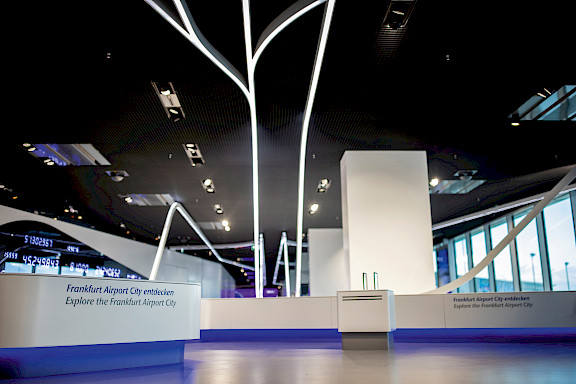
There is hardly anything more majestic than a large aircraft gliding towards the ground. With a unique light installation, Frankfurt Airport is bringing this elegance to life. Over 325 metres and two storeys, the central element of the exhibition winds its way through the new visitor centre and precisely traces the flight paths and holding patterns of the large jets as they take off and land. A 14-metre-long and 8-metre-wide model of the airport incroporates the light line into the exhibitions model runway.
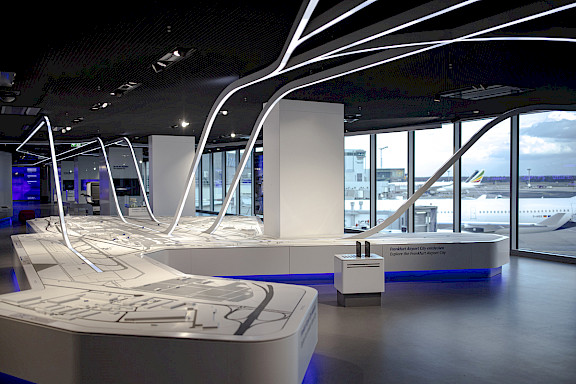

Project photos: Tomas Rodriguez

Alexander Zell, Head of Customer Service FRAPORT AG
The new heart of the airport begins to beat
In the centre of Frankfurt Airport, in Hall C of Terminal 1, flying becomes a new experience. The world's only multimedia exhibition all about the fascination of aviation is now opening up on 1200 square metres in the new visitor centre. For Alexander Zell, head of customer service at the airport operator FRAPORT AG, the centre is "a new generation of customer service". The main goal is to show areas that "you don't normally get to see as a flight guest" and in this way make the airport, with its approximately 20 million passengers per year, an attractive destination for excursions.
A number of interactive highlights await the visitors. As a "Marshaller", they can wave an aircraft into parking position, experience for themselves the journey of a suitcase through the baggage conveyor system at Frankfurt Airport in a cinema with VR glasses and movable armchairs. On the 25-square-metre interactive hub wall "The Globe" consisting of 28 LCD displays, all flights worldwide can be followed in real time. Through 2.5-metre-high Smart Windows with touch function, visitors can look out onto the apron and receive additional information on the visible aircraft.
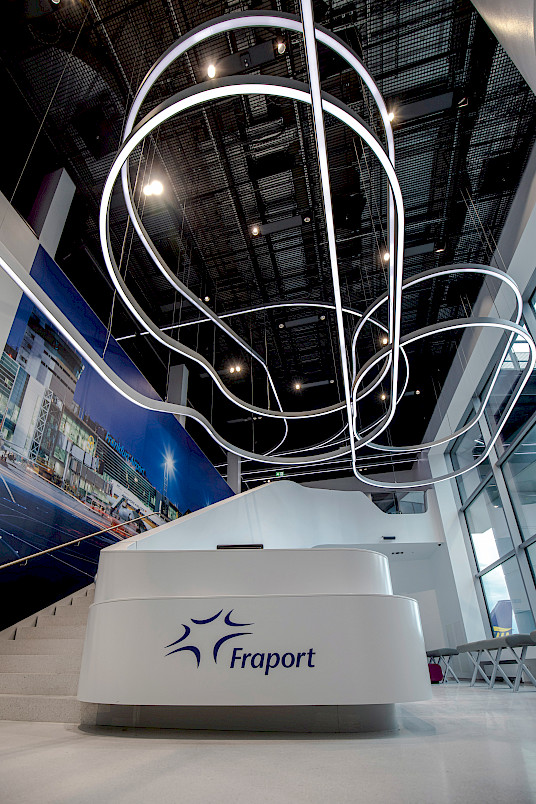
The Liquid Line physically manifests what can otherwise only be experienced as a snapshot: the holding patterns of the planes on their landing approach to Frankfurt Airport.
Even these impressive exhibits are outshone by the true-to-scale model of the entire Frankfurt Airport, which extends into the entire exhibition via the light installation as a signpost, orientation aid and explanatory object. According to Jochen Gringmuth from COORDINATION Berlin, the Architectural practice responbile for the design, the idea of the main exhibit was to show the size of the airport not only on the ground but also in the air: "To display the approach and departure of the planes and to back it up with a physical installation, using Liquid Line was the only solution for us." The enormity of the flight paths could only be captured by creating them on a scale of 1:1500; the airport is shown twice as large. Nevertheless, the light installation remains very close to reality. The steep angles of the take-off movements are very clearly recognisable, and the frequency of the running lights is based on the actual flight movements in 2019.


Jochen Gringmuth, architect and founder of COORDINATION Berlin, Photo: Asja Caspari
Welcome!
Enjoy the tour of the Visitor Centre along the Liquid Line light installation
A challenge in many dimensions
What visitors experience intuitively was technical new territory in several respects for the lighting designer Anne Boissel and her manufacturing partner Lightnet. In order to realise the architects' vision, a profile was needed that was flexible enough to be bent both horizontally and vertically, allowing for a variety of branches. At the same time, a very precise and flexible control system was needed for the running light. It became clear relatively quickly that the usual control via DALI would not be sufficient. Instead, Anne Boissel opted for a technical platform that is the standard in show business but has hardly been used in architecture so far. Each of the 2300 boards can be controlled individually via DMX. For this purpose, Lightnet developed a completely new sub-board with DMX controller, the software for the control was also newly programmed by Stageled. "For me, the subject of control was new, I am actually responsible for light art and light planning," Anne Boissel looks back on the beginnings of the project. The installation also had to meet special requirements in terms of light colour: "The light installation refers to the flight lines from the airport, one thinks of the vapour trails from the sky. That's why the exceptionally cool light colour 5700 K."
Added to this were the technical conditions on site. The elongated shape of the installation required the utmost precision in shaping, while at the same time the existing functional ceiling offered only a very small number of points for suspension and cable routing. For fire protection, the installation also had to be interrupted at firmly specifically defined points. The sum of these requirements meant that only one manufacturer applied for the tender. For Axel Tiebel, the managing director of Lightnet, this was not surprising: "This project was made for us! On the one hand, with Liquid Line we already had a product in our portfolio that can implement very diverse curves in all dimensions. On the other hand, we combine very deep expertise in mechanics, electrical engineering and surface finishing in-house, coupled with a way of thinking that makes it possible to react unusually openly to unusual tasks like this one."
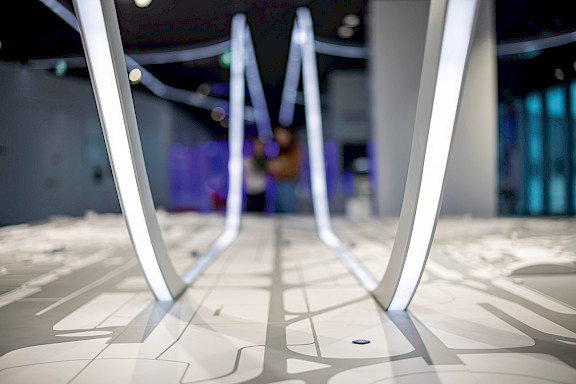
-
Axel Tiebel
The real challenge of such a project lies in the early recognition of potential problems to enable a timely solution.
Managing director Lightnet
-
Jochen Gringmuth
The light installation creates a very identitary moment for the visitor centre.
Architect and founder of COORDINATION Berlin
Light installation visitor centre Frankfurt Airport
Product: Liquid Line
Chaser via DMX controller
Individually developed sub-circuit boards with DMX controller
Design of all components in fire protection class B1
Project duration 02/2017 - 07/2020
325
Metres total length
2300
Boards
5700
K | Light colour


Axel Tiebel, Managing Director Lightnet, Photo: Felix von der Osten
Shape diversity based on a proven solution
The big advantage for Lightnet was that an existing product could be used for the lighting installation. The Liquid Line profile from Lightnet enables flexible light lines that can be bent and branched in any dimension using CNC processes, using not only standard products but custom radii.
This was important to lighting designer Anne Boissel: "In this project I really wanted to use an existing profile to avoid technical problems." With Lightnet, she could draw on experience from previous projects and rely on this proven partner. Liquid Line was developed by Lightnet to meet the wishes of architects for a light line that harmonises with the increasingly organic and dynamic design language of our time. The flexibility of LED technology finds its fitting counterpart in the versatile design of the profile. After initial scepticism, architect Jochen Gringmuth was quickly won over by Liquid Line: "We were glad that we could fall back on a product that already existed and that could also be accommodated well in the very complicated ceiling construction." The project at Frankfurt Airport is seen by Lightnet as confirmation of their product policy and production philosophy: "At our company, electronics and mechanics are designed and manufactured in-house. This competence enables us to respond very flexibly to the planners' wishes," says Managing Director Axel Tiebel, summarising the approach. The products are not produced for stock, but always just in time for all orders large or small. In most cases, this is more cost effective than producing higher quantiities for stock, as warehousing has a cost. In addition, there are ecological advantages due to waste of resources being significantly reduced.
-
Axel Tiebel
With our in-house design and manufacturing expertise in electronics and mechanics, we can respond very flexibly to the planners' wishes.
Managing director Lightnet
The result exceeds all expectations
What began in 2017 with Anne Boissel's first request to Lightnet ended in July 2020 with the successful completion and handover of the installation. It wasn't always clear. In particular, the close relationship between the construction progress on site and production required close coordination at a distance to ensure on time delivery in three stages.
The logistics in a highly sensitive security area such as the airport and the interlocking with the other construction activities on site were also quite challenging. For example, the 10-metre-high scaffolding had to be dismantled and reassembled at short notice for the screed laying. Under these circumstances, the good cooperation with Lide GmbH as the installation company and their high quality standards paid off - not a matter of course in the international project business.
Everyone involved in the project is delighted with the result. Alexander Zell from FRAPORT is impressed by "how exactly the installation reproduces reality". Architect Jochen Gringmuth almost goes into raptures: "The effect is even greater than I had hoped. When you see how the architecture is played with by the curved light lines and stages an overall effect that is easily recognisable from all perspectives - then you see that the light installation always creates a very identitary moment for the visitor centre." Axel Tiebel of Lightnet has his own reason to be happy besides the satisfaction of the clients: the installation can be admired by an audience of millions at the airport since August 2021 - and also by colleagues in the industry who will be coming to Light & Building in Frankfurt in March 2022. "Personally, I'm pleased that this installation is so visible to a wide audience and that on one of our next holidays I can show my children what Lightnet and Dad do during the day."
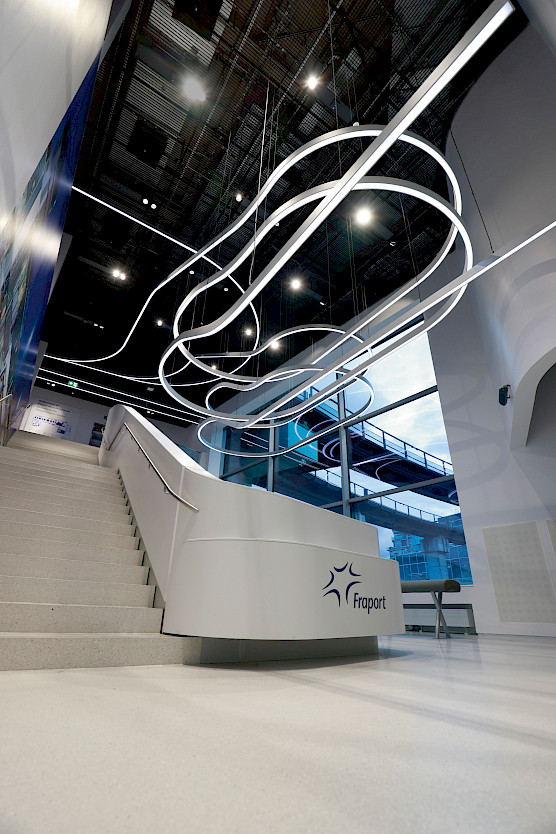
-
Alexander Zell
I am impressed by how accurately the installation traces reality.
Head of Customer Service FRAPORT AG
-
Jochen Gringmuth
The impact is even greater than I had hoped. The feeling in the space - that is what sets this installation apart from the ordinary.
Architect and founder of COORDINATION Berlin
-
Axel Tiebel
Constructive cooperation is what makes projects so successful.
Managing Director Lightnet
Project profile
-
Customer
-
Lighting designer
-
Components
-
Technical development and implementation
Lightnet GmbH, Cologne
-
Architects
Jochen Gringmuth and Andrea Dunmore, COORDINATION Berlin
-
Installation
-
Control system
-
Project participants
Ralf Posorski and Christoph Willim
